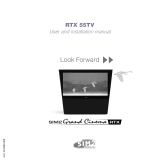
Wireless Motion Detector
G
18
Scope of Delivery
Wireless motion detector 1
Batteries 3 x AA batteries
Assembly material Screws, dowels
Wall bracket 1
Instruction manual 1
Please check the contents of the package carefully. If anything is missing or has
been damaged during transport, DO NOT put the water leak detector into opera
tion!
Installation
Recommended Installation Locations
The installation location must be within transmission range of the base unit of
the Protect series alarm system.
The installation location of the wireless motion detector must be selected so that
an intruder must pass through the area monitored.
An optimal installation location is directly in a corner, between 2 and 3 meters
above the floor at an angle of 14 degrees. The possible direction of movement of
an intruder should be frontal towards the wireless motion detector.
Inappropriate Installation Locations
The area monitored by the wireless motion detector should not be obstructed by
objects (e.g. furniture, curtains, etc.).
Avoid locations in which there is a quick temperature change in the area moni
tored; near an air-con unit or heater, for example.
No pets should have access to the area to be monitored by the wireless mo
tion detector when the alarm system is armed.
Wall Installation
WARNING!
• Risk of serious injuries through damaging cables or lines!
During installation, pay attention to the possibility of cables running in
the walls. We are not deemed liable for installation errors. If in doubt, con
tact a specialist!
The wireless motion detector is provided with a wall bracket which can be mount
ed on a wall as well as on a ceiling.
1. Screw the wall bracket to the chosen installation location using two screws
approx. 45 mm apart. (It may be necessary to drill the two holes first and then
insert dowels in which to tighten the screws, depending on the properties of the
wall.) Refer to Fig. 3.
2. Hook the wireless motion detector over the pins on the wall bracket and pull the
housing downwards a little.
Inserting the Batteries
1. Use a screwdriver to loosen the screw in the battery compartment cover on the
rear side of the wireless motion detector.
2. Remove the battery compartment cover.
3. Insert the AA batteries in the battery compartment (pay attention to correct
polarity). Refer to Fig. 2.
4. Replace the battery compartment cover.
5. Replace and tighten the screw.





















